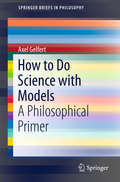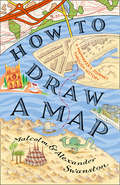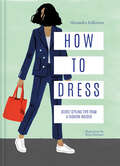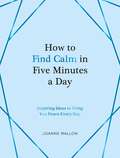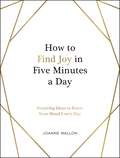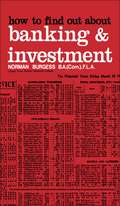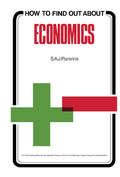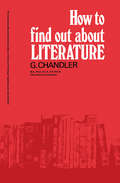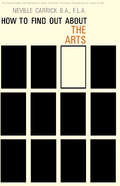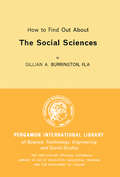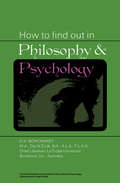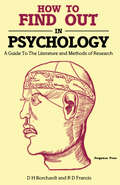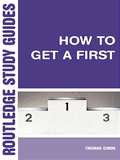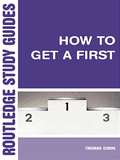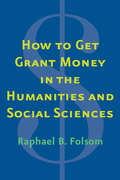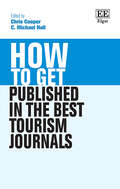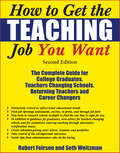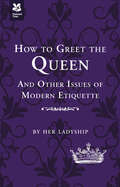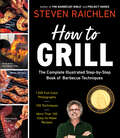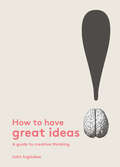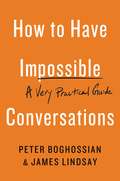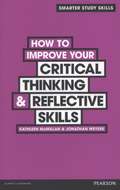- Table View
- List View
How to Do Science with Models: A Philosophical Primer (SpringerBriefs in Philosophy #0)
by Axel GelfertTaking scientific practice as its starting point, this book charts the complex territory of models used in science. It examines what scientific models are and what their function is. Reliance on models is pervasive in science, and scientists often need to construct models in order to explain or predict anything of interest at all. The diversity of kinds of models one finds in science – ranging from toy models and scale models to theoretical and mathematical models – has attracted attention not only from scientists, but also from philosophers, sociologists, and historians of science. This has given rise to a wide variety of case studies that look at the different uses to which models have been put in specific scientific contexts. By exploring current debates on the use and building of models via cutting-edge examples drawn from physics and biology, the book provides broad insight into the methodology of modelling in the natural sciences. It pairs specific arguments with introductory material relating to the ontology and the function of models, and provides some historical context to the debates as well as a sketch of general positions in the philosophy of scientific models in the process.
How to Draw a Map
by Malcolm Swanston Alex SwanstonHow to Draw a Map is a fascinating meditation on the centuries-old art of map-making, from the first astronomical maps to the sophisticated GPS guides of today.
How to Dress: Secret Styling Tips From A Fashion Insider
by Alexandra FullertonThe perfect book for anyone who wants to know the secrets to always looking stylish with minimal effort.
How to Find Calm in Five Minutes a Day: Inspiring Ideas to Bring You Peace Every Day
by Joanne MallonThis book includes over 60 prompts and ideas to help you pause for peace and connect to calm every single day - and each tip takes no longer than five minutes Pockets of calm are all around us, even on the busiest of days - and they're easy to find when you know where to look. All you need is five minutes. Guiding you through each stage of your day, these soothing rituals will help you to recentre yourself and rise above everyday stresses. Tips include:- How to incorporate mindfulness into your routine- Starting the day with a relaxation exercise and a calming mantra- Visualizing what calm looks like to you- Writing down your worries to gain focus and perspectiveEven the smallest moment of calm can transform your outlook, so whether you follow one tip or many, you're sure to de-stress, boost your well-being and find clarity and calm every day.
How to Find Joy in Five Minutes a Day: Inspiring Ideas to Boost Your Mood Every Day
by Joanne MallonJoy is all around us. It’s in the first sip of a cup of tea, the beauty of a sunrise, or the simple pleasure of a deep breath, and it’s easy to find when you know where to look. All you need is five minutes. This book includes over 60 prompts and ideas to help you to find joy every single day. Taking you through your morning, your afternoon and your evening, these tips will help you to elevate your mood and liven up your routine – and each one takes no longer than five minutes.Tips include:Setting an intention for your dayPerforming a small act of kindnessEating outdoors in the fresh airTrying a grounding ritualEven the smallest moment of positivity can transform your outlook, so whether you follow one tip or many, you’re sure to lift your spirits and find a small oasis of happiness every day.
How to Find Out About Banking and Investment: The Commonwealth and International Library: Libraries and Technical Information Division
by Norman BurgessHow to Find Out About Banking and Investment focuses on the sources of information on banking and investment. The publication first ponders on careers, dictionaries and encyclopedias, and libraries and guides to libraries. Discussions focus on guides to the resources of libraries, Banking Information Service, Bank Education Service, education and examinations in America, sources of information on careers, finance houses, joint stock banking, foreign and merchant banks, and the London Stock Exchange. The text then takes a look at bibliographies and literature guides, periodical literature, financial economics, banks and banking, and central banking classification. Topics include library catalogues, guides to reference works, periodicals concerned with banking and finance, money and banking in the United States, financial institutions and economic development, banking in Europe, European Economic Community, and banking in the United States. The book takes a look at interest and discount, credit and instruments of credit, foreign and overseas investment, and merchant and investment banking.The publication is a dependable source of information for researchers and bankers wanting to explore banking and investment.
How to Find Out About Economics: The Commonwealth and International Library: Libraries and Technical Information Division
by S. A. ParsonsHow to Find Out About Economics focuses on information sources related to economics, including books, periodicals, government publications, and national and international organizations. The sources of arranged according to the Dewey Decimal Classification used by many libraries. This book is comprised of 17 chapters and begins with an overview of modern economics and guides to careers in economics. The following chapters focus on sources of employment registers and careers advice in economics; career and vocational guidance in the United States; and career patterns for economists. The discussion then turns to two categories of information relating to economics: bibliographical sources such as books, periodicals, abstracts, and similar printed documents; and non-bibliographical sources such as organizations and societies formed, for example, by economists or persons having an interest in economics. The book also considers libraries and their functions; guides to library resources; sources of education for careers in economics; and sources of economic history, business history, and biography. This monograph will be a useful resource for students and others interested in embarking on a career in economics.
How to Find Out About Literature
by G. ChandlerHow to Find Out About Literature aims to provide a general survey of literatures and a general indication of the dates of these literatures. The book first elaborates on how to study and appreciate literature and how to trace literary works, including exercises and universal and national bibliographies. The text then examines how to trace poetry, drama, novels, and prose, foreign and subject bibliographies, library and sale catalogues, and guides to libraries, and literary information on general reference books and encyclopedias. The manuscript discusses how to trace literary information in handbooks and concordances to poetry and drama, handbooks and reference books on novelists and prose writers, dictionaries and guides to the English language and specialized subjects, essays, theses, and periodical articles. The text ponders on how to trace periodical articles and literary abstracts. The book is a valuable reference for students and researchers in their studies.
How to Find Out About the Arts: A Guide to Sources of Information
by Neville CarrickHow to Find Out About the Arts: A Guide to Sources of Information discusses the main sources of information, printed or otherwise, in the field of the arts. The book begins by describing where information on art careers can be found. Separate chapters then discuss how information on art can be traced in libraries by means of the catalogue and classification scheme; and turning to bibliographies when information on a particular aspect of art cannot be traced by these means. Subsequent chapters deal with sources such as encyclopedias and dictionaries, general indexes to reproductions and portraits, works on iconography, periodicals, directories, yearbooks, and sales records. This book aims to serve some of the needs of the student of art, the experienced artist, and indeed all of those with an intelligent interest in the arts. In particular, it should help those in libraries, colleges, and other educational institutions whose task it is to guide others to the right sources.
How to Find Out About the Social Sciences: Library and Technical Information
by Gillian A. BurringtonHow to Find Out About The Social Sciences indicates the sources of information in the social sciences that are traditionally taught in social science faculties in universities. The book delineates the scope and nature of the different social sciences, explains the necessary education and training, and lists possible careers for those who take up the studies. The book also lists the possible sources of information such as organizations, libraries, books and other published material, and social administration. Lastly, it explains the significance of the different sources of information, what kind of information could be derived from them, and how they can be used to learn or teach in the social sciences. The text is for social scientists, professors, and researchers on the discipline and its many branches. It is also recommended for undergraduate and graduate students alike, as well as those who have taken a casual interest on the social sciences.
How to Find Out About the Victorian Period: A Guide to Sources of Information
by Lionel MaddenHow to Find Out About the Victorian Period: A Guide to Sources of Information focuses on the Victorian period of Great Britain. The book first discusses the study of the Victorian period and general guides to the literature. The use of books, periodical articles, theses, and bibliographies in the study of this period in British history is emphasized. The text underscores the value of Victorian periodicals and newspapers in the study of the Victorian period. Guides to special collections and source materials on this period are discussed. These include guides to collection of books and manuscripts, libraries and their collections, archives and manuscripts, and government publications. The book also presents guides to the study of the Victorian church. These include encyclopedias and dictionaries, biographical works, and theses. Guides on the kind of education, development of science, visual arts, music, and literature of the Victorian period are also described. The text is a fine reference for readers who are interested in British history, particularly the Victorian era.
How to Find Out in Philosophy and Psychology: The Commonwealth and International Library: Library and Technical Information Division
by D. H. BorchardtHow to Find Out in Philosophy and Psychology is a guidebook for accessing various philosophical and psychological literatures. The coverage of the text includes dictionaries, journals, encyclopedias, and handbooks. The selection also covers various kinds of bibliographies, such as national, general retrospective, and bibliographies of specialized fields. The last chapter tackles various philosophical and psychological organizations. The book will be of great use to students who needs to have access to various philosophical and psychological materials.
How to Find Out in Psychology: A Guide to the Literature and Methods of Research
by D. H. Borchardt R. D. FrancisHow to Find Out in Psychology: A Guide to the Literature and Methods of Research is a research guidebook in psychology. The book is comprised of 11 chapters that address concerns in psychological research. The text first covers the concept of psychology and its major theories, and then proceeds to tackling bibliographic aids for research in psychology. The next series of chapters details the methodologies in researching and presenting. The last chapters discuss the professional matters in psychology. The book will be of great use to students, researchers, and practitioners of behavioral science.
How to Get a First: The Essential Guide to Academic Success
by Thomas DixonIn this informative guide, Thomas Dixon argues that you do not have to be a genius to get a first at university. He sets out to de-mystify first-class degrees in the arts, humanities and social sciences, clearly articulating the difference between the excellent and the merely competent in undergraduate work. This concise, no-nonsense guidebook will give prospective and current students advice on teaching and learning styles that prevail in university and on how to manage their two most important resources - their time and their lecturers. In an accessible and entertaining style, the author looks at subjects such as: making the transition from school to university developing transferable skills making use of lectures and seminars using libraries and the Internet note-taking, essays, seminars and presentations common mistakes to avoid writing with clarity and style revision and examinations. Illustrated with many examples from a range of academic disciplines, How to Get a First is an all-purpose guide to success in academic life. Visit the companion website www.getafirst.com
How to Get a First: The Essential Guide to Academic Success
by Thomas DixonIn this informative guide, Thomas Dixon argues that you do not have to be a genius to get a first at university. He sets out to de-mystify first-class degrees in the arts, humanities and social sciences, clearly articulating the difference between the excellent and the merely competent in undergraduate work. This concise, no-nonsense guidebook will give prospective and current students advice on teaching and learning styles that prevail in university and on how to manage their two most important resources - their time and their lecturers. In an accessible and entertaining style, the author looks at subjects such as: making the transition from school to university developing transferable skills making use of lectures and seminars using libraries and the Internet note-taking, essays, seminars and presentations common mistakes to avoid writing with clarity and style revision and examinations. Illustrated with many examples from a range of academic disciplines, How to Get a First is an all-purpose guide to success in academic life. Visit the companion website www.getafirst.com
How To Get A First: The Essential Guide To Academic Success (PDF)
by Thomas DixonIn this informative guide, Thomas Dixon argues that you do not have to be a genius to get a first at university. He sets out to de-mystify first-class degrees in the arts, humanities and social sciences, clearly articulating the difference between the excellent and the merely competent in undergraduate work. This concise, no-nonsense guidebook will give prospective and current students advice on teaching and learning styles that prevail in university and on how to manage their two most important resources - their time and their lecturers. In an accessible and entertaining style, the author looks at subjects such as: making the transition from school to university developing transferable skills making use of lectures and seminars using libraries and the Internet note-taking, essays, seminars and presentations common mistakes to avoid writing with clarity and style revision and examinations. Illustrated with many examples from a range of academic disciplines, How to Get a First is an all-purpose guide to success in academic life. Visit the companion website www. getafirst. com
How to Get Grant Money in the Humanities and Social Sciences
by Raphael Brewster FolsomA valuable and engaging guide to applying for—and getting—grants in the humanities and social sciences Scholars in the humanities and social sciences need money to do research. This book shows them how to get it. In this accessible volume, Raphael Folsom shares proven strategies in a series of short, witty chapters. It features tips on how graduate students, postdocs, and young faculty members can present themselves and their work in the best possible light. The book covers the basics of the grant-writing process, including finding a mentor, organizing a writing workshop, conceptualizing the project on a larger scale, and tailoring an application for specific submissions. The book includes interviews with nine of the most respected scholars in the country, each of whom has evaluated thousands of grant applications. The first authoritative book on the subject, Folsom's indispensable work will become a must-have resource for years to come.
How to Get Published in the Best Tourism Journals (How To Guides)
Drawing on a wealth of knowledge and experience from leading tourism academics and journal editors, this practical How To guide offers clear-sighted advice on how to craft a high-quality paper in terms of contribution, positioning and submission. Accessible and comprehensive, it demystifies the process of getting published in the top tourism journals.This insightful book begins by mapping out the tourism publishing landscape, before delving into the various methods of building a refereed journal paper and navigating tourism publishers. Chapters dissect contemporary publishing issues, including gender inequality, ethics and integrity, and the dominance of English language publishing. Finally, contributors outline the essential role of publishing in shaping an academic career in tourism, especially in securing jobs, obtaining grant funding and creating pathways for career progression.How to Get Published in the Best Tourism Journals offers an insider perspective and practical advice while posing questions about the future of tourism publishing in the light of developments such as AI and Open Access. It will prove an essential resource to enhance journal publication success for tourism PhD students, as well as tourism academics at all career stages.
How to Get the Teaching Job You Want: The Complete Guide for College Graduates, Teachers Changing Schools, Returning Teachers and Career Changers
by Robert Feirsen Seth WeitzmanCompetition for the best teaching jobs is becoming more intense. Since publication of the first edition, when it was mainly the most desirable schools that were deluged by applications, the economic climate has made the teacher market more competitive across the board, and is changing hiring practices. Now extensively revised, this book maintains its place as the most up-to-date book available on job hunting for teachers. The authors cover changes in the educational marketplace; the new mandates about standardized testing and public reporting of student achievement–and what they mean for applicants; how new certification standards and schools’ requirements affect career changers; the growing acceptance of on-line applications and electronic portfolios; and provide additional advice for teachers applying to change schools or districts.This is also the only guide written by school administrators. Offering the insights and experience of two authors who do the hiring, it details a step-by-step program for taking charge of your teaching career. How to Get the Teaching Job You Want enables you to:* Match your unique talents to the needs of a particular school* Craft effective cover letters and resumes, using models that address the specific needs of college graduates, teachers changing schools, returning teachers and career changers* Make effective on-line applications* Leverage your achievements as an experienced teacher–or, for graduates or career changers, student teaching, substitute teaching, volunteer work or content knowledge–into a job offer* Locate jobs on-line and discover valuable information about schools, including test results, educational philosophy and names of key administrators* Design a portfolio in book or electronic format to showcase your abilities* Practice interview skills using 100 questions taken from real job interviews* Apply proven strategies for a variety of interview formats, including high stress interviews and performance interviews* Address controversial questions during interviewsThis book covers procedures for applying to elementary, middle and high schools; public, independent, and parochial schools; as well as international and boarding schools. Anecdotes recounting the experiences of real candidates looking for jobs illustrate key points. Access to the authors’ web site ensures that you will stay current in a changing job market. This is a vital book for teachers and aspiring teachers who want to achieve their career goals. It will also be invaluable for guidance counselors, psychologists, librarians and other school professionals.
How to Get the Teaching Job You Want: The Complete Guide for College Graduates, Teachers Changing Schools, Returning Teachers and Career Changers
by Robert Feirsen Seth WeitzmanCompetition for the best teaching jobs is becoming more intense. Since publication of the first edition, when it was mainly the most desirable schools that were deluged by applications, the economic climate has made the teacher market more competitive across the board, and is changing hiring practices. Now extensively revised, this book maintains its place as the most up-to-date book available on job hunting for teachers. The authors cover changes in the educational marketplace; the new mandates about standardized testing and public reporting of student achievement–and what they mean for applicants; how new certification standards and schools’ requirements affect career changers; the growing acceptance of on-line applications and electronic portfolios; and provide additional advice for teachers applying to change schools or districts.This is also the only guide written by school administrators. Offering the insights and experience of two authors who do the hiring, it details a step-by-step program for taking charge of your teaching career. How to Get the Teaching Job You Want enables you to:* Match your unique talents to the needs of a particular school* Craft effective cover letters and resumes, using models that address the specific needs of college graduates, teachers changing schools, returning teachers and career changers* Make effective on-line applications* Leverage your achievements as an experienced teacher–or, for graduates or career changers, student teaching, substitute teaching, volunteer work or content knowledge–into a job offer* Locate jobs on-line and discover valuable information about schools, including test results, educational philosophy and names of key administrators* Design a portfolio in book or electronic format to showcase your abilities* Practice interview skills using 100 questions taken from real job interviews* Apply proven strategies for a variety of interview formats, including high stress interviews and performance interviews* Address controversial questions during interviewsThis book covers procedures for applying to elementary, middle and high schools; public, independent, and parochial schools; as well as international and boarding schools. Anecdotes recounting the experiences of real candidates looking for jobs illustrate key points. Access to the authors’ web site ensures that you will stay current in a changing job market. This is a vital book for teachers and aspiring teachers who want to achieve their career goals. It will also be invaluable for guidance counselors, psychologists, librarians and other school professionals.
How to Greet the Queen: And Other Questions Of Modern Etiquette (National Trust History And Heritage Ser.)
by Caroline TaggartPractical and invaluable advice on every aspect of modern etiquette, both royal and everyday. The author, Her Ladyship, guides you through basic good manners in a range of situations, both formal and informal occasions, whether at home or at work or abroad.
How to Grill: The Complete Illustrated Book of Barbecue Techniques, A Barbecue Bible! Cookbook
by Steven RaichlenWinner of an IACP Cookbook Award, How to Grill is &“the definitive how-to guide for anyone passionate about grilling, from the newest beginner to the most sophisticated chef&” (Tom Colicchio).
How to Have Great Ideas: A Guide to Creative Thinking
by John IngledewHow to Have Great Ideas is the essential guide for students and young professionals looking to embrace creative thinking in design, advertising and communications. It provides 53 practical strategies for unlocking innovative ideas.Strategies include improvisation techniques, changing the scenery, finding hidden links, looking to nature for inspiration, combining unusual systems, challenging set boundaries and many more. Each strategy is packed with great examples of successful contemporary and historical designs – from a designer dress made out of an old typewriter to ticket machines powered by recycled bottles in China, via the reimagining of famous brand logos and mis-use of photocopiers.Packed with practical projects to kick-start inventive thought in idea-blocked moments, this book explores creative thinking across all visual arts disciplines.
How to Have Impossible Conversations: A Very Practical Guide
by Peter Boghossian James Lindsay"This is a self-help book on how to argue effectively, conciliate, and gently persuade. The authors admit to getting it wrong in their own past conversations. One by one, I recognize the same mistakes in me. The world would be a better place if everyone read this book." -- Richard Dawkins, author of Science in the Soul and Outgrowing GodIn our current political climate, it seems impossible to have a reasonable conversation with anyone who has a different opinion. Whether you're online, in a classroom, an office, a town hall -- or just hoping to get through a family dinner with a stubborn relative -- dialogue shuts down when perspectives clash. Heated debates often lead to insults and shaming, blocking any possibility of productive discourse. Everyone seems to be on a hair trigger.In How to Have Impossible Conversations, Peter Boghossian and James Lindsay guide you through the straightforward, practical, conversational techniques necessary for every successful conversation -- whether the issue is climate change, religious faith, gender identity, race, poverty, immigration, or gun control. Boghossian and Lindsay teach the subtle art of instilling doubts and opening minds. They cover everything from learning the fundamentals for good conversations to achieving expert-level techniques to deal with hardliners and extremists. This book is the manual everyone needs to foster a climate of civility, connection, and empathy.
How To Improve Your Critical Thinking And Reflective Skills
by Jonathan Weyers Kathleen McmillanNew to the highly successful Smarter Study Skills series comes this essential guide to thinking and writing critically. This easy-to-use guide identifies and addresses the key areas where most students need help in developing and enhancing the critical thinking and writing skills that are crucial to successful academic study, and provides practical tips and solutions. The authors use real life examples to illustrate common mistakes and demonstrate how to avoid them. They provide solid advice on enhancing analytical and argumentation skills by adopting best practice with critical thinking and reflective writing.
